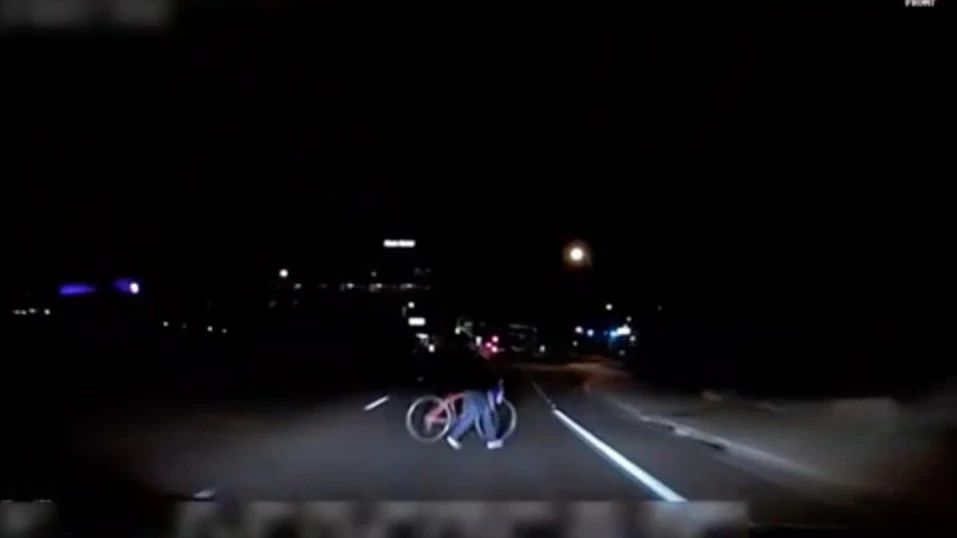✉️ Instant Message Follow Weibo @42 Garage
Add WeChat (ID: nopanic42) to join the discussion group.
Around 10 pm on March 18th, a fatal accident occurred in Tempe, Arizona, USA, involving a Uber autonomous vehicle that hit and killed a pedestrian. Although not the first accident involving autonomous vehicles, it is the first accident that resulted in pedestrian death.
For more details, please refer to our previous article.
Currently, the latest evidence released by the police includes video data from the vehicle. The video shows the situation inside and outside the vehicle when the accident occurred.
Based on this video, let’s take a look at the breakdown of the scenes:

According to the information above, let’s take a look at what happened at the time of the accident:
-
Lighting conditions: The accident occurred around 10 pm at night, and the only source of illumination was the street lamp. The pedestrian was standing at the edge of the street lamp’s coverage.
-
Road environment: The road consisted of a normal two-lane road with a non-motorized lane, and there were no traffic lights or sidewalks. The accident did not occur at any intersection. Besides the pedestrian and the vehicle involved, there were no other objects on the road.### 3. Vehicle Distance and Speed:
A pedestrian pushing a bicycle crosses two lanes, and the video captures the pedestrian crossing the second lane, which takes about 2 seconds. Based on this, the entire crossing process may take 4-5 seconds.
According to the police, the vehicle was traveling at 38 mph (61 km/h). Based on a lane width of 2 meters and a crossing time of 2 seconds, the pedestrian’s speed is estimated to be 1 m/s. Therefore, the vehicle was approximately 68-85 meters away from the accident site when the pedestrian stepped into the lane.
4. Obstacle Color:
The pedestrian was wearing a black top, blue pants, and a yellow hat, and was pushing a red bicycle.
5. Safety Observer:
The safety observer was seated in the front row, wearing a seatbelt, and was not looking at the road for most of the time. At the last moment when they looked at the road, the collision had already occurred, so there was no opportunity for them to take control of the vehicle.
6. Vehicle Information:
The Uber-modified Volvo XC90 is equipped with Velodyne HDL-64 LiDAR and other sensors such as cameras. According to the Velodyne website, the HDL-64 has a detection range of 120 meters, which includes the range of the accident. Although the pedestrian’s clothing color is bright, the camera may have difficulty detecting the pedestrian due to lighting conditions.
According to Zhou Yanwu, the research director of Zosi Technology, in this scenario, the LiDAR is capable of detecting the pedestrian, but the Uber algorithm prioritizes processing pedestrian information with the camera’s vision, resulting in a delayed response. In other words, the reason why the self-driving vehicle did not respond in time may be due to the problem of algorithm integration.
Additionally, Zhou also mentioned that most algorithms currently use visual detection to detect pedestrians and rarely utilize LiDAR. If this is the case, most self-driving vehicle algorithms may not be able to meet the requirements of this accident. Therefore, the case of Uber may be considered a typical example.
In conclusion, regarding this accident, the responsibility of the safety observer who did not keep their attention on the road the whole time is a matter for the police to handle. In this context, we only discuss the limitations of current self-driving technology, whether it is possible to avoid such accidents, and whether stricter regulation of safety observers in self-driving vehicles is necessary.
If there are any mistakes or omissions in the content of this article, please leave us a message. Thank you.
-
Breaking News! World’s First Fatal Accident Caused by Self-Driving Vehicle
-
Tesla Autopilot Fatal Crash Investigation Concluded: NHTSA Clears Tesla

This article is a translation by ChatGPT of a Chinese report from 42HOW. If you have any questions about it, please email bd@42how.com.
